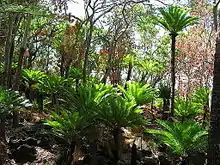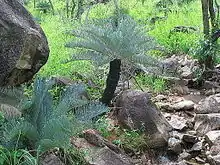Cycas
Cycas is a genus of plants belonging to a very ancient lineage, the Cycadophyta, which are not closely related to palms, ferns, trees or any other modern group of plants. They are evergreen perennials which achieved their maximum diversity in the Jurassic and Cretaceous periods, when they were distributed almost worldwide. At the end of the Cretaceous, when the non-avian dinosaurs became extinct, so did most of the cycas in the Northern Hemisphere.
| Cycas | |
|---|---|
 | |
| A large cycas under development | |
| Scientific classification | |
| Kingdom: | Plantae |
| Clade: | Tracheophytes |
| Division: | Cycadophyta |
| Class: | Cycadopsida |
| Order: | Cycadales |
| Suborder: | Cycadineae |
| Family: | Cycadaceae Pers.[1] |
| Genus: | Cycas L.[2] |
| Type species | |
| C. circinalis[2] L.[2] | |
| Synonyms[3] | |
| |
Cycas is the type genus and the only genus recognised in the family Cycadaceae. About 113 species are accepted.[4] Cycas circinalis, a species endemic to India, was the first cycad species to be described in western literature, and was the type of the generic name, Cycas. The best-known Cycas species is Cycas revoluta.
Range
The genus is native to the Old World, with the species concentrated around the equatorial regions - eastern and southeastern Asia including the Philippines with 10 species (9 of which are endemic), eastern Africa (including Madagascar), northern Australia, Polynesia, and Micronesia. Australia has 26 species, while the Indo-Chinese area has about 30. India has 9 species. The northernmost species (C. revoluta) is found at 31°N in southern Japan. The southernmost (C. megacarpa) is found at 26°S in southeast Queensland. Due to the occurrence of large number of Cycas species in China, Australia and India, those countries are considered as centres of Cycas diversity.[3]


Evolution

The earliest fossils of the genus Cycas appear in the Cenozoic although Cycas-like fossils that may belong to Cycadaceae extend well into the Mesozoic. Cycas is not closely related to other genera of cycads, and phylogenetic studies have shown that Cycadaceae is the sister-group to all other extant cycads.[5] Cycas is thought to retain a number of ancestral characters that have been modified in the other cycads (Stangeriaceae and Zamiaceae): in particular, the ovulate ('female') cone has very large ovules attached to megasporophylls that are held in a lax rosette rather than in the tight cone found in other cycads.
Morphology
The plants are dioecious, and the family Cycadaceae is unique among the cycads in not forming seed cones on female plants, but rather a group of leaf-like structures called megasporophylls each with seeds on the lower margins, and pollen cones or strobilus on male individuals.



The caudex is cylindrical, surrounded by the persistent petiole bases. Most species form distinct branched or unbranched trunks but in some species the main trunk can be subterranean with the leaf crown appearing to arise directly from the ground. There are two types of leaves - foliage leaves and scaly leaves. The foliage leaves are pinnate (or more rarely bipinnate) and arranged spirally, with thick and hard keratinose. They are not permanent and fall off leaving back leaf-bases. The leaflets are articulated, have midrib but lack secondary veins. The scaly leaves are persistent, brown in colour and protective in function. Megasporophylls are not gathered in cones. Pollination takes place by air.
Reproduction
The plant takes several years to grow, sexual reproduction takes place after 10 years of exclusive vegetative growth which occurs by bulbils arising at the base of the trunk.

Conservation status
Cycas species are threatened worldwide and almost all the species are listed in IUCN Redlist. Cycas beddomei is the only species of the genus Cycas listed in Appendix I of CITES. Cycas rumphii and Cycas pectinata have the most widespread distribution.
List of species
- Cycas aculeata
- Cycas aenigma
- Cycas angulata
- Cycas annaikalensis
- Cycas apoa
- Cycas arenicola
- Cycas armstrongii
- Cycas arnhemica
- Cycas badensis
- Cycas balansae
- Cycas basaltica
- Cycas beddomei
- Cycas bifida
- Cycas bougainvilleana
- Cycas brachycantha
- Cycas brunnea
- Cycas cairnsiana
- Cycas calcicola
- Cycas campestris
- Cycas canalis
- Cycas candida
- Cycas cantafolia
- Cycas chamaoensis
- Cycas changjiangensis
- Cycas chenii
- Cycas chevalieri
- Cycas circinalis
- Cycas clivicola
- Cycas collina
- Cycas condaoensis
- Cycas conferta
- Cycas couttsiana
- Cycas cupida
- Cycas curranii
- Cycas debaoensis
- Cycas desolata
- Cycas diannanensis
- Cycas dolichophylla
- Cycas edentata
- Cycas elephantipes
- Cycas elongata
- Cycas falcata
- Cycas fairylakea
- Cycas ferruginea
- Cycas fugax
- Cycas furfuracea
- Cycas glauca
- Cycas guizhouensis
- Cycas hainanensis
- Cycas hoabinhensis
- Cycas hongheensis
- Cycas indica (=Cycas swamyi)
- Cycas inermis
- Cycas javana
- Cycas lacrimans
- Cycas lane-poolei
- Cycas lindstromii
- Cycas litoralis
- Cycas maconochiei
- Cycas macrocarpa
- Cycas media
- Cycas megacarpa
- Cycas micholitzii
- Cycas micronesica
- Cycas montana
- Cycas multipinnata
- Cycas nathorstii
- Cycas nayagarhensis
- Cycas nitida
- Cycas nongnoochiae
- Cycas ophiolitica
- Cycas orientis
- Cycas orixensis
- Cycas pachypoda
- Cycas panzhihuaensis
- Cycas papuana
- Cycas pectinata
- Cycas petraea
- Cycas platyphylla
- Cycas pranburiensis
- Cycas pruinosa
- Cycas revoluta (Sago palm)
- Cycas riuminiana
- Cycas rumphiiMiq.
- Cycas sancti-lasallei
- Cycas sainathii
- Cycas saxatilis
- Cycas schumanniana
- Cycas scratchleyana
- Cycas seemannii A.Braun
- Cycas segmentifida
- Cycas semota
- Cycas sexseminifera
- Cycas shanyaensis
- Cycas siamensis
- Cycas silvestris
- Cycas simplicipinna
- Cycas sphaerica
- Cycas sundaica
- Cycas szechuanensis
- Cycas taitungensis
- Cycas taiwaniana
- Cycas tanqingii
- Cycas tansachana
- Cycas thouarsii
- Cycas tropophylla
- Cycas tuckeri
- Cycas vespertilio
- Cycas wadei
- Cycas xipholepis
- Cycas yorkiana
- Cycas yunnanensis
- Cycas zambalensis
- Cycas zeylanica
References
- Kramer, K.U.; (illustrations), P.S. Green; assisted by E. Götz (1990). Kramer, K.U.; Green, P.S. (eds.). Pteridophytes and Gymnosperms. Berlin: Springer-Verlag. p. 370. ISBN 978-3-540-51794-8.CS1 maint: uses authors parameter (link)
- Hill, Ken; Leonie Stanberg; Dennis Stevenson. "The Cycad Pages". Genus Cycas. Royal Botanic Gardens Sydney. Retrieved 6 September 2013.
- Kew World Checklist of Selected Plant Families
- The World List of Cycads
- Nagalingum, N. S.; Marshall, C. R.; Quental, T. B.; Rai, H. S.; Little, D. P.; Mathews, S. (20 October 2011). "Recent synchronous radiation of a living fossil". Science. 334 (6057): 796–799. doi:10.1126/science.1209926. PMID 22021670.
External links
| Wikimedia Commons has media related to Cycas. |
| Wikispecies has information related to Cycas. |
- de Laubenfels, D.J.; Adema, F. (1998). "A taxonomic revision of the genera Cycas and Epicycas Gen. Nov. (Cycadaceae)". Blumea. 43: 351–400.
- Hill, K.D.(1998–2004) The Cycad Pages, Royal Botanic Gardens Sydney. http://plantnet.rbgsyd.nsw.gov.au/PlantNet/cycad/index.html
- Virtual Cycad Encyclopedia edited by the Palm & Cycad Societies of Florida
- David, J. de Laubenfels, Cycas Taxonomy
- Hill, K.D.; Stevenson, Dennis W.; Osborne, Roy (2004). "The World List of Cycads". The Botanical Review. 70 (2): 274–298. doi:10.1663/0006-8101(2004)070[0274:TWLOC]2.0.CO;2.
- Lindstrom, Anders J.; Hill, Ken D. (2007). "The genus Cycas (Cycadaceae) in India". Telopea. 11 (4): 463–488. doi:10.7751/telopea20075745.
- Singh, R & JS Khuraijam (2013-) Cycads of India. http://www.cycadsofindia.in/
- Singh, R.; Radha, P.; Khuraijam, J.S. (2015). "A new species, a new combination and a new subsection of Cycas from Odisha, northern Eastern Ghats of India". Asian Journal of Conservation Biology. 4 (1): 3–14.
- Singh, R.; Radha, P. (2006). "Cycas annaikalensis, A new species of Cycas from the Malabar Coast, Western Ghats, India". Brittonia. 58 (2): 119–123. doi:10.1663/0007-196x(2006)58[119:ansocf]2.0.co;2.
- Terrence Walters & Roy Osborne (eds.) (2004), Cycad Classification: Concepts and Recommendations, CABI publishing, ISBN 0-85199-741-4